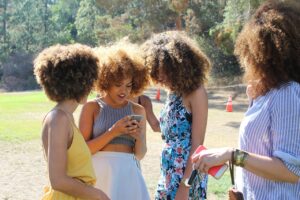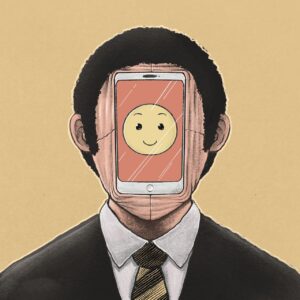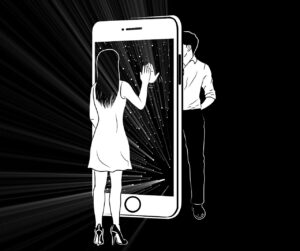Can you give me your Snap for this class?
“Can you snap me?”
“What is on your FYP?”
“Facetime me after school!”
“Did you see what he said in the group chat?!”
The world we grew up as millennials has evolved. Social media has become the dominant form of communication for our students. Children have never been more connected to each other throughout history. At the tap of a screen, our students can enter into a room with all of their friends, classmates, or complete strangers. They can send a photo around the world and have it “disappear” in a few short seconds. They can learn about any subject in just a few hours without needing to read a single thing. The possibilities seem almost endless thanks to the introduction of social media.
As a teacher, I’ve seen both the benefits and the detriments of social media in education. On one hand, it encourages connection, community and curiosity. On the other hand, I’ve watched it destroy the essence of childhood imagination, the privacy of social situations, and self-control. While social media can be used responsibly, I believe its constant presence, lack of regulation, and addictive design are fundamentally reshaping childhood in damaging ways.
There are numerous benefits for students using social media in educational settings, as long as it’s done responsibly and with intention. These platforms can connect students with professionals and experts who bring fresh perspectives and enriching content to lessons. We have seen Chris Hadfield stream from the International Space Station, so students can experience the wonder science can provide. Students connect with classrooms as “pen pals” through Twitter. Authors, singers, dancers, and motivational speakers need not worry about distance and the possibility of presenting to classes thanks to the popularity of Zoom and Teams. For example, I once invited my brother, an actor, to speak to our Grade 7 and 8 students over Zoom about the many facets of drama (from stage to film and voice work). It was an incredibly rewarding experience (for all involved) that showcased aspects of the subject not typically offered in class.
Social media also opens up a world of diverse resources and global connections. Students can connect and collaborate with peers from other classrooms and cultures, building empathy, appreciation for global issues, and cultural understanding. As a French immersion teacher, this is an important benefit. Students can connect with other French speaking students to learn about culture, practice language, and build community. These connections amplify voices that might otherwise go unheard and help students develop a broader worldview. This, then, fosters critical thinking and supports civic engagement, either from a political activism or participation viewpoint. During elections, for instance, teachers can use social media to encourage student involvement in democratic processes at the civic, provincial, and federal levels. I found that when I included platforms students were acquainted with, they were more likely to interact with the material because there was a common ground they could participate in. Politics were less likely to be seen as an “old persons” issue. That being said, it is important to critically reflect on if your impact matches your intent when including this media in your lesson.
Finally, social media supports communication in both academic and social contexts. It became especially vital during the COVID-19 pandemic when we were confined to our homes. Social media platforms helped maintain our sense of connection and community, preventing many students and educators from feeling isolated. While this connection was vital, it also had unintentional consequences such as forming echo chambers of specific opinions with no critical voice.
While social media can offer educational benefits, its impact on the emotional welfare and well being of children and students is deeply concerning. From failing to socially connect with peers to being incapable to use communication skills in the physical world, students skill sets are shifting. However, a major concern with this reshaped interpersonal relationship concept is cyberbullying. Today, bullying doesn’t stop when the school day ends, it follows students home with their devices. This constant exposure can hurt their mental health, school performance, and overall confidence . With the rise of AI and image manipulation tools, bullying has entered a disturbing and destructive era. Altered photos, demeaning memes, and deepfake videos or voice recordings can be spread instantly without consent. These malicious attacks leave lasting emotional damage and doxing anxiety. These are, in part, some of the reasons we’re seeing more student anxiety and depression.
Social media also affects student privacy and safety. Many students believe that platforms like Snapchat provides anonymity due to the disappearing message function. In reality, content be saved, screenshotted, or reposted without the sender’s knowledge or consent. Also, Snapchat stores these messages for legal purposes. Games and apps (ex. Roblox) can expose children to strangers, despite parental controls. Troubling cases have uncovered how predators utilize these platforms to groom, manipulate, and access vulnerable youth. There are even covert online communities that encourage self-harm and suicidal ideation. While law enforcement agencies, such as the FBI(US) and ICE (Can), are actively intervening, the anonymity (and sheer mass of perpetrators) of the internet continues to protect many offenders from consequences. These are not isolated incidents but part of a larger digital culture that students are ill-equipped to independently navigate safely.
While we have already discussed anxiety and depression, social media also disrupts child development. Engineered to maximize engagement, social media distracts students from their studies, hobbies, relationships, and healthy lifestyle choices. Constant exposure to deliberately curated social media algorithms fuel insecurity, body image issues, and creates a sense of worthlessness. Students compare their personal struggles to someone else’s highlight reel. This results in an idealization of unattainable standards that they will never be able to attain. Unfortunately, students will attempt to achieve these standards to the detriment of their relationships, health and (in some cases) lives. This constant conditioning to overshare and seek validation further perpetuates students’ mental health struggles.
As a millennial, I’m grateful that my teenage mistakes weren’t captured online, in Tweets, Facebook statuses, or viral videos for the world to see. Today Gen Z and Gen Alpha don’t have that same luxury. Their childhoods are playing out publicly, without fully understanding how permanent or far-reaching a post can be. This information can be shared and bought for nefarious purposes. Furthermore, while we say “kids will be kids,” and that their posts shouldn’t define them, we often fail to apply that same grace later in life. Even deleted content can be stored, screenshotted, or reposted, creating a digital footprint that may affect future opportunities as an adult. Adults are routinely judged on their old content, even after years of growth and change. Prime examples of this include Reddit threads like r/AgedLikeMilk and r/LeopardsAteMyFace, where past social media content is resurfaced to public shame the creator.
In the end, social media can be overwhelming for students. Parents, educators, or legal protections need to set strong boundaries, so students are not left vulnerable to a digital world that demands their attention and allegiance, but rarely supports their growth. The long-term consequences from limited oversight are becoming evident with increasing mental health crises, lower academic performance, and emotional instability. Social media has reshaped childhood and eliminated the freedom to fail privately. This, in my opinion, is a loss worth grieving. Effective social media use demands careful parental supervision, critical thinking skill building, and strict boundaries to safeguard students’ privacy while maximizing its educational possibilities.



Hello,
I really enjoyed reading your post. Call me traditional, but I still believe in giving my kids a chance to experience a simple, carefree childhood, one where they can make mistakes, learn, and grow without the fear of those moments being permanently stored or shared online. While I understand that mobile phones can help kids stay connected, nothing compares to face-to-face interactions. It’s through real conversations and shared experiences that children build genuine friendships and lasting social skills.
This reflection does an excellent job of highlighting the double-edged sword that is social media in students’ lives. One powerful point is the way social media can connect students to real-world experiences and global perspectives. Your example of inviting your brother to speak about drama through Zoom shows how social media and technology can enrich learning beyond the classroom walls. These tools allow educators to bring in diverse voices, break down barriers, and keep lessons relevant and engaging, especially when students already use these platforms in their daily lives.
However, one critique is that while the dangers of social media are explained in depth, the tone leans heavily toward fear-based outcomes. It paints a picture of a digital world almost too dangerous to navigate without substantial adult intervention. While this concern is valid, it might unintentionally suggest that students are powerless in their own digital lives. More focus could be placed on student agency—how we can teach students to recognize harmful content, manage privacy, and practice ethical digital behavior. Empowering students with media literacy and self-regulation strategies is just as important as adult control. A more balanced view of both protection and empowerment might help readers feel more hopeful and proactive rather than overwhelmed.